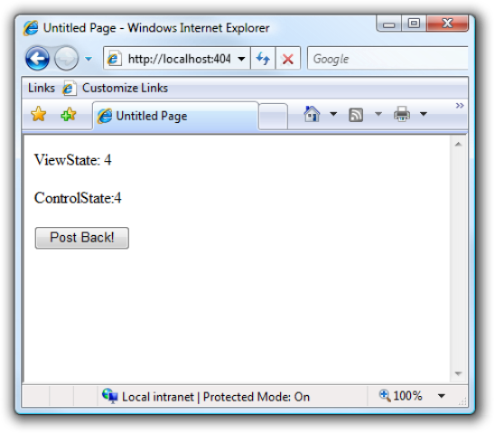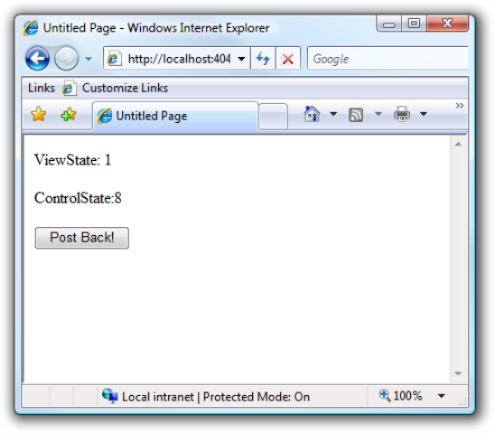Gain Control Of Your Control State
Some people think the ViewState is the spawn of the
devil.
Not one to be afraid of being in bed with the devil, I feel a tad bit
less negative towards it, as it can be very useful.
Still, it has its share of disadvantages. It sure can get bloated. Not only that, but disabling ViewState can wreack havock with the functionality of many controls.
This is why ASP.NET 2.0 introduces the control state. The basic idea
is that there is some state that should be considered the data for the
control, while other state is necessary for the control to function.
For example, the contents of a GridView. The control doesn’t absolutely
need this data persisted across postbacks to function properly. You
could choose to reload it from the database, Cache, or Session.
In contrast is the state of the selected node in a TreeView. This is
state that is necessary for the control to function properly across
postbacks.
Unlike the ViewState, the control state isn’t implemented as a
property bag. You have to do a little bit of extra work to make use of
it. Namely, there are two methods you have to implement in your custom
control.
LoadControlState– Restores the control state from a previous page request. ASP.NET calls this method passing in the control state as an object to this method.SaveControlState– Saves any changes to control state since the last post back. You need to return the state of the control as the return value of this method. ASP.NET will store it.
Your custom control must also register the fact that it needs the
control state by calling Page.RegisterRequireControlState.
A Demonstration That Makes This All Clear As Mud
I’ve put together a simple control to demonstrate the control state. Now before I go any further, I must warn you not to copy and paste this implementation. This implementation is designed to clarify how the control state works. I will present another implementation that describes a safer approach, which you can feel free to copy and paste. You’ll see what I mean.
public class ControlStateDemo : WebControl
{
public int ViewPostCount
{
get { return (int)(ViewState["ViewProp"] ?? 0); }
set { ViewState["ViewProp"] = value; }
}
public int ControlPostCount
{
get { return controlPostCount; }
set { controlPostCount = value; }
}
private int controlPostCount;
protected override void OnInit(EventArgs e)
{
//Let the page know this control needs the control state.
Page.RegisterRequiresControlState(this);
base.OnInit(e);
}
protected override void OnLoad(EventArgs e)
{
ViewPostCount++;
ControlPostCount++;
base.OnLoad(e);
}
protected override void Render(HtmlTextWriter writer)
{
writer.Write("<p>ViewState: " + this.ViewPostCount + "</p>");
writer.Write("<p>ControlState:" + this.ControlPostCount + "</p>");
base.Render(writer);
}
protected override void LoadControlState(object savedState)
{
int state = (int)(savedState ?? 0);
this.controlPostCount = state;
}
protected override object SaveControlState()
{
return controlPostCount;
}
}
This control has two properties. One backed by the ViewState and the
other backed by a private member variable. Notice that we register this
control with the Page in the OnInit method.
In the OnLoad method, we increment each property. For demonstration
purposes, we need these properties to change on each postback, and this
is as good a method as any.
In the Render method, we simply output the values of the two
properties. So far so good, eh?
Now we get to the LoadControlState method. This method is called by
ASP.NET early in the control lifecyle (after OnInit but before
LoadViewState) in order to provide your control with the saved control
state from the previous request.
In this case, we can cast this value to an int and set the control’s state (the value of controlPostCount) to this value.
The SaveControlState method provides ASP.NET the data to store in the
control state as the return value. In this example, we return the value
of controlPostCount. This is how we knew we could cast the value to an
int in LoadControlState.
Now if I drop this control onto a page with a Button control, let’s see what happens after a few postbacks.

As expected, both values increment, as they are persisted across postbacks. But what happens if we disable ViewState on the page and click the button a few more times.

As you can see, we retain the control state, while the ViewState is
disabled.
But What About Inherited Controls?
I am so glad you asked! In this example, I inherited from WebControl,
but what if I inherited from TreeControl, or some other control that
made use of the control state. My implementation of LoadControlState
and SaveControlState pretty much obliterates the control state for the
base class.
The class I wrote here is intentionally simple to show you no real magic is going on. Let’s demonstrate the proper way to save and load the control state by creating a class that inherits from this control.
public class SubControlStateDemo : ControlStateDemo
{
public int AnotherCount
{
get { return this.anotherCount; }
set { this.anotherCount = value; }
}
private int anotherCount;
protected override void OnLoad(EventArgs e)
{
AnotherCount++;
base.OnLoad(e);
}
protected override void Render(HtmlTextWriter writer)
{
base.Render(writer);
writer.Write("<p>AnotherCount:" + this.AnotherCount + "</p>");
}
protected override object SaveControlState()
{
//grab the state for the base control.
object baseState = base.SaveControlState();
//create an array to hold the base control’s state
//and this control’s state.
object thisState = new object[] {baseState, this.anotherCount};
return thisState;
}
protected override void LoadControlState(object savedState)
{
object[] stateLastRequest = (object[]) savedState;
//Grab the state for the base class
//and give it to it.
object baseState = stateLastRequest[0];
base.LoadControlState(baseState);
//Now load this control’s state.
this.anotherCount = (int) stateLastRequest[1];
}
}
In this control, we inherit from the ControlStateDemo control I wrote
earlier and added a new property called AnotherCount. The main thing
to focus on here is our new implementation of SaveControlState and
LoadControlState. We now take great pains to make sure that the base
control gets the value it is expecting.
In SaveControlState, the first thing we do is grab the control state
from the base control by calling base.SaveControlState. As you recall,
this holds the value for the private member controlPostCount.
Since we want to add our own private member, anotherCount to the
control state, we create an array to store both values and then return
this array to the caller.
Within the LoadControlState method, we know we’re going to be passed
in an object array and that the first element of the array is the
control state for our base class. So in that method, we grab the first
element and pass it to the method call base.LoadControlState, thus
giving the base class what it expects to receive for its control state.
We then grab the second element, which is our control state, and set
anotherCount to this value.
Let’s look at a screenshot of the result in action. Looks like everything is humming along nicely.

I would recommend using this approach anytime you implement control state in a custom control because you never know when you might override the control state for a base class.
Comments
5 responses